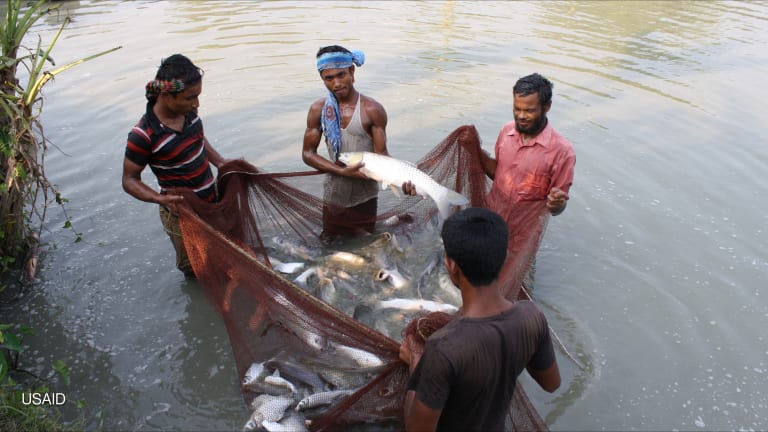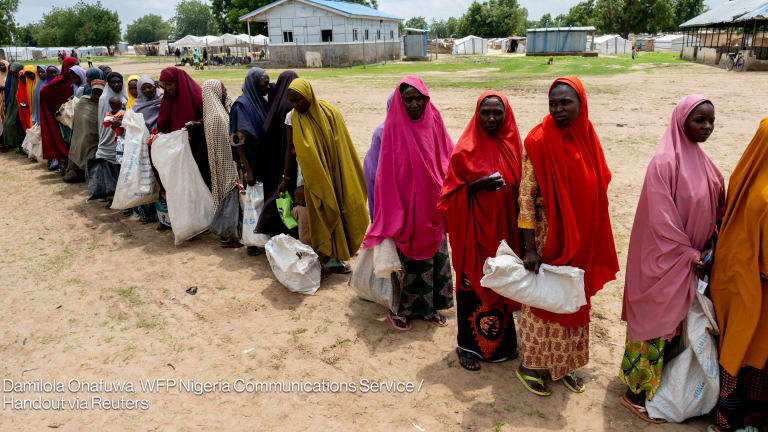
MUTUA VILLAGE, Mozambique — Francisca Santos stands in the rubble of what was once her home. When Cyclone Idai hit Mozambique in March, her house was ripped apart. She spent the night huddled under a bush with her two grandsons as the storm ravaged her community. For two weeks after that, the three of them stayed with others in a church that had lost its roof during the storm.
She was able to recover some of the food she had in the house. When that ran out, the three of them went several days without eating. It wasn’t until two weeks after the storm that she started to receive food aid from donors.
Santos is now living in a temporary structure, cobbled together with some of the pieces of her old home, held together with plastic sheets that a man in the community helped her build. It’s keeping her and her grandsons protected from the rain, but every time the weather changes, she worries another cyclone will come and rip it apart.
Santos supports herself and her grandsons with farming but the flooding that followed the cyclone destroyed all of her crops.
“I worry constantly about providing for my grandsons,” she said.
Mozambique was pummeled with two Category 4 cyclones in the span of only six weeks this year, creating one of the worst weather-related disasters to hit the southern hemisphere on record. Cyclone Idai destroyed about 1.8 million acres of crops and Cyclone Kenneth destroyed another 70,000 acres.
Because of this, widespread dependency on food aid its expected to continue until the next main harvest, in April of next year.
“This is the so-called ‘third emergency,’” said Jean-Dominique Bodard, senior emergency response manager at CARE. “The first emergency was Cyclone Idai, the second was Cyclone Kenneth, and the third will be this food security situation that can strike the people if they don’t get proper support.”
Since the response and recovery efforts are underfunded, humanitarian responders are concerned the people may not get the support they need.
“The main challenge is funding. We noticed there is a funding fatigue from the side of the donor community.”
— Olman Serrano, FAO country representative, Mozambique‘Crisis’ conditions
Despite the World Food Programme’s stocks of pre-positioned food items, many families were stranded without food in the weeks after the cyclones. Reaching communities was a main challenge for the humanitarian response because roads were blocked and the airport was not functional.
Rita Nazare and her family, for example, were stuck clinging to a tree for a week after her village was flooded before they were rescued. They ate sand for several days when the food they had carried up the tree ran out.
A team from Refugees International met with communities impacted by Cyclone Idai who were receiving their first emergency food distribution at the end of May — over two months after the storm.
“When informed about the assistance, they traveled by foot and crossed two rivers to reach the main road and receive food. Funding is needed not only for food, but also to continue reaching people who live far from the main roads,” wrote the organization.
Since March, WFP, its partners, and the government have provided over 1.4 million people with in-kind food distributions and vouchers, which people can use to buy food in markets.
This dependency is expected to continue into next year. Beyond losing homes, many people lost their only source of income. About 80% of Mozambique’s labor force works in agriculture, which accounts for more than a quarter of Mozambique’s GDP.
According to the latest update from the Famine Early Warning System Network, “crisis” food conditions are expected to persist throughout pockets of the country until April 2020.
“I am deeply concerned for the months ahead, as food insecurity is expected to rise due to the extensive damage to crops and livelihoods,” said Ursula Mueller, assistant secretary-general for humanitarian affairs and deputy emergency relief coordinator at OCHA, during a recent trip to Mozambique.
Preparing for the 2020 harvest
The country has two growing seasons. The main harvest starts around April and a secondary, smaller harvest, starts around August. This second harvest only provides enough crops for immediate consumption, rather than storage.
A good main harvest would help to reduce levels of food insecurity. But one concern is whether impacted families will have access to seeds and other agricultural inputs.
The Food and Agriculture Organization and NGOs are working to distribute seeds and agricultural inputs to farmers. FAO, for example, is using an e-voucher system to provide 7,000 farmers that were impacted by the cyclones with about $37 each to buy seeds and other farming inputs. FAO and the Mozambique Ministry of Agriculture and Food Security also distributed agricultural kits containing hoes, machetes, and early-maturing maize and bean seeds.
"The basis of livelihoods of rural families is agriculture; therefore seeds distribution is a critical element if we want to restore the productive capacity of the affected households," Bodard said.
Beyond agriculture, another group hit hard by the cyclones were artisanal fishers. Over 2,000 fishing vessels were destroyed, according to the government.
But the ability to reach these populations could be stunted if funding falls short, humanitarian responders told Devex. Both the emergency response and long-term recovery efforts are underfunded.
“The main challenge is funding. We noticed there is a funding fatigue from the side of the donor community,” said Olman Serrano, FAO country representative in Mozambique.
In the Mozambique Food Security Cluster, which is organizing the food aid response, ongoing activities are severely underfunded. For the Cyclone Idai response, only about half of the activities are funded and in the Cyclone Kenneth response, only about 10% are funded, he said.
Investing in climate preparedness
Mozambique is no stranger to natural disasters. Both droughts and tropical cyclones occur regularly. The country is also downstream of nine major river basins, making it prone to flooding.
Food insecurity from the cyclones is compounded by an ongoing drought in the southern, semi-arid region of the country, which is dealing with a second consecutive poor harvest.
“Agricultural productivity and production for the 2018-2019 main season was already expected to be quite low due to drought conditions in many southern and central areas of the country,” wrote the government in a post-cyclone needs assessment. Between September and December of last year, some 1.78 million people were severely food insecure in the country.
With the changing climate, it is projected that cyclones could decrease in numbers globally, but increase in intensity and accompanying rainfall. The World Meteorological Organization also predicts sea-level rise will increase the impact of storm surge on coastal regions. Mozambique’s coastline is about 1,500 miles long.
Beyond weather-related disasters, planting seasons have also become unpredictable.
“It’s not just these big events that are happening. It’s the unpredictability of the seasons,” said Saul Butters, CARE’s assistant country director in Mozambique. “People are living much more on the edge and the food security issue is becoming a bigger and bigger challenge.”
In May, FAO published preliminary findings from a study that examined the nature of agriculture-related investments made globally in disaster risk reduction and management.
It found that agriculture-related official development assistance allocations in Africa to prevention and preparedness tend to occur during or after a large-scale disaster, rather than in its anticipation. Almost half of official development assistance was focused on agriculture emergency responses, with only 1% on prevention and preparedness — which included flood prevention and control.
FAO’s guidelines for best practices in agricultural investment programs include protecting watersheds, establishing flood retention zones, changing cropping patterns, mapping out hazard zones, improving irrigation and drainage systems, and establishing disaster and crop insurance schemes.
“The way we work has changed drastically over the last three months. We were running about 20 development projects before the crisis,” Serrano said. “We just hope to find that balance so that we can phase slowly out of the emergency and get back into development, and towards actually rebuilding the agriculture system.”
Editor’s note: CARE facilitated Devex's travel and logistics for this reporting with support from the Bill & Melinda Gates Foundation. Devex maintains full editorial independence and control of the content.








